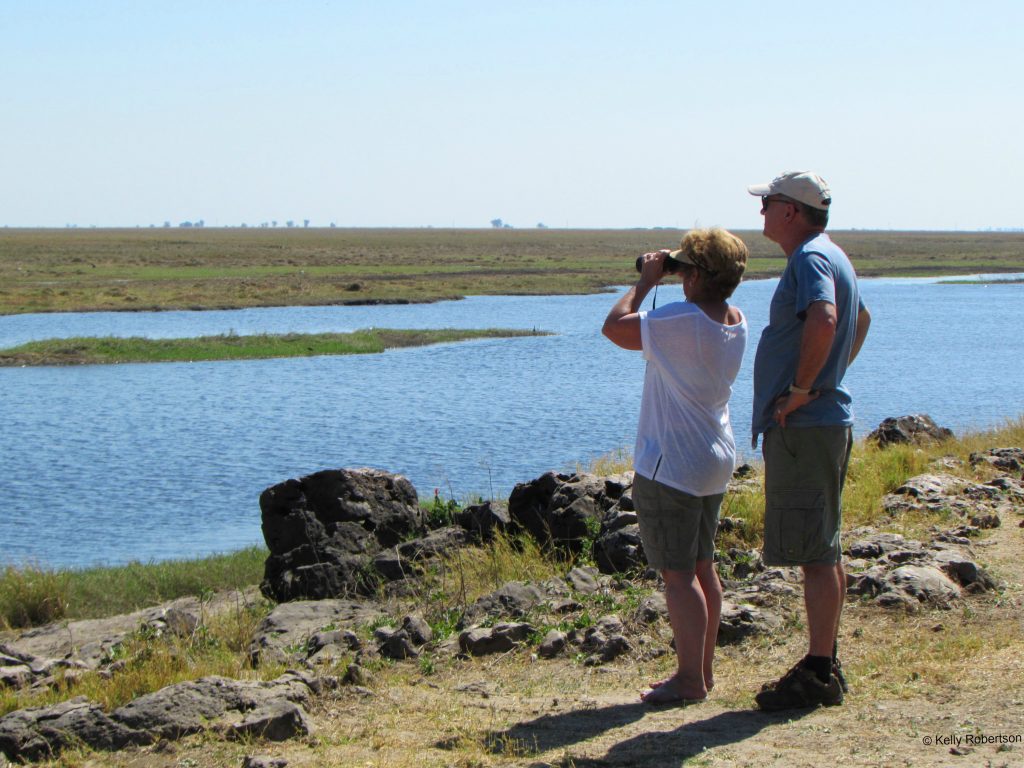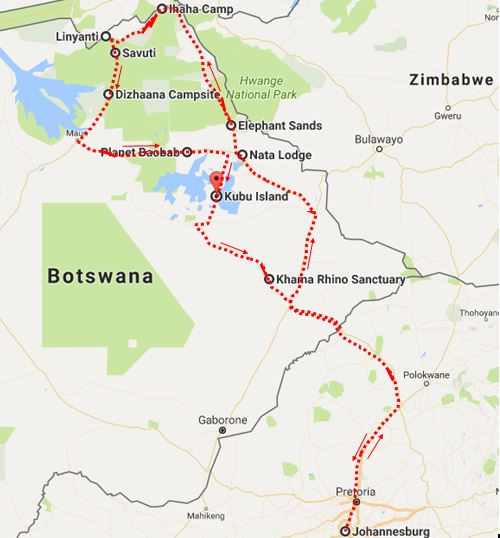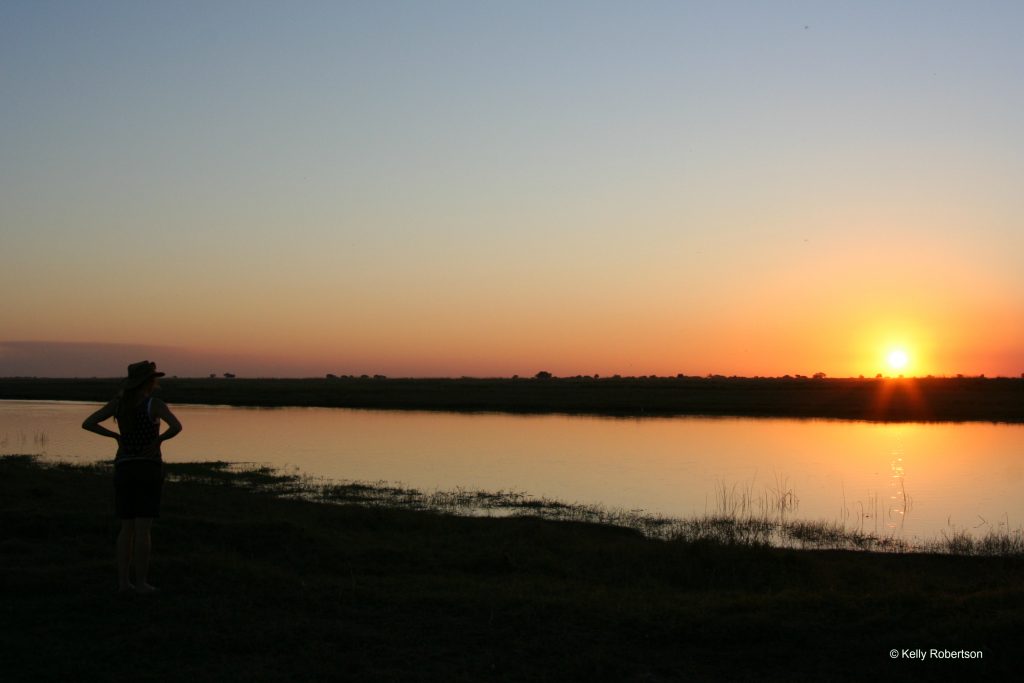
Blog Series: A Botswana Camping Adventure (Part 1 of 6)
3400kms travelled. 4 happy campers. 2 reliable and cherished 4x4s. 12 nights camping in Botswana. 850 photos. And a suitcase full of memories taken home.
We ended each day, clambering into our rooftop tents, with dusty feet, shining eyes and hearts so full from all we had experienced.

Adventure called. And we answered it.
We were a herd of four, exploring Botswana on a self-drive, camping holiday which we had been counting down to for months. It was July 2017 and our herd was made up of my mom, dad, husband, me, and our two trusty 4x4s – Paddy the Pajero and Priscilla the Patrol. We embraced those sandy roads, incredible views, and wild camps with even wilder visitors who passed through them from time to time.

Our herd, on route from Ihaha to Linyanti

Big skies and big landscapes, camping at Kubu Island.
Unfenced campsites
“We’re playing in God’s garden.” That’s how my dad aptly described our setting and situation one day. We were gazing at an elephant in the distance, across the Chobe River and some impala were drinking just a few steps away while we sipped sundowners in our camping chairs. We were the only humans in that scene and nature was allowing us the temporary honour of being part of it for a while.

Immersed in nature,from a camping chair at Ihaha Camp

Elephant herds rule the Chobe National Park
We were at one of our “homes” during that trip, at Ihaha camp, set inside the Chobe National Park. It was completely unfenced (like most other camps in Botswana National Parks, game reserves and many outside camps too). This characteristic of Botswana campsites was one of the greatest appeals and a constant source of excitement for us as camping instantly made us part of the wilderness. While being one with nature in the various campsites on our trip we did battle with a mischievous baboon (we named “Rafikki”) as he outwitted us and managed to help himself to some of our breakfast snacks… twice. We scrambled into the elevated safety of our tents when the hyena cackles sounded like they were getting too close for comfort at night. We shuddered and then smiled in our beds as lion roars reverberated through our pillows as they called out very nearby and we found their paw prints next to the ablutions the next morning. We watched hippos gulp down water plants right beside our camp, like giant lawn mowers, their snorts and gurgles so loud we could hear their feasting enjoyment. We had a naughty bull elephant invite himself over for gin and tonics while we excused ourselves rapidly, bundled into the car and watched him just outside the window from within our sanctuary.

A rooftop tent room with a view of the Chobe flood plains.

Part of a pride of 18 lions we met in Chobe National Park.

Campfire stories are an every night affair when camping in Botswana
“We lived in the bush. Literally. No fences like in our South African game parks. And we experienced it all.” My mom recalls and describes the nature of our stay in this way. We were wild and free with the wild things.

Watching wildlife watching us, across the Chobe River floodplains.

Catching the first morning sun rays next to the Chobe River
The route
Our 12 night route took us from Johannesburg on a long journey to Nata (via Stockpoort border post.) We revelled in a sunset escapade to a personal favourite spot at Nata Bird Sanctuary and had a good sleep at Nata Lodge campsite to start us off. We chilled out with the ellies on a relaxed day at Elephant Sands and then traversed to Chobe National Park (Ihaha, Linyanti and Savuti camps). Then it was onto the Moremi Game Reserve area near Khwai (Dizhana campsite), onwards to Gweta (Planet Baobab) and to Kubu Island in the Makgadikgadi Pans. Finally we headed homewards with a mandatory stop at the well-loved Khama Rhino Sanctuary near Serowe, where we completed our “Big 5” tick list.

3400 kms travelled. 4 happy campers. 2 reliable 4x4s. 12 nights camping in Botswana.
We rocked and rolled along bumpy dirt roads, through villages and wilderness. We urged our cars on with shouts of encouragement through thick sand near Savute and even through a water crossing in Khwai. We jiggled and bumped along on corrugated pathways and navigated narrow trails with bushes scratching at us with their thorny fingers. We shared appreciative sighs when a stretch of tar came along in all its smoothness too.
We felt and lived every kilometre.

White sand and wide smiles in the Makgadikgadi Pans

Scouting out how far away our other herd members were from us, on a particularly challenging sandy track near Savute region.

Eating the Makgadikgadi dust at Nata Bird Sanctuary in Botswana
A day by day account of our trip
In the blogs to follow, I’ll share our detailed, personal experiences on each day of our amazing self-drive, Botswana camping adventure. These will be divided into parts in this blog series.
Please follow along, in order, from the Bushbaby Blog home page as we go, and reach out with any questions or comments. I love to hear from you.
Graham has already shared a trip report review about our journey on the 4×4 Community Forum:
Read that here for a great overview.

Pajero and Patrol on the Pans

Sharing sundowners with the rhinos
Some details, info and tips- based on our trip experience:
-
How we booked and cost:
I’m a fan of booking direct when planning our trips, mainly to have control over exactly what kind of experience and stay we have. However, for this big, self-drive camping trip I broke my rule (after lots of convincing by Graham) and used an expert to deal with all the fiddly admin around booking Botswana camps. Tara from Botswana Footprints was our fantastic tour operator and is very active on the 4×4 Community forum, giving constant advice to all Botswana travellers. She assisted us in securing our bookings at each of the independently managed camps we wanted to stay at.
In Botswana, the camping spots are all run by different operators (even if camps are in the same reserve), making it quite the stressful job to find availability from each before managing your own booking itinerary and the process of confirming the bookings. (See this Getaway article about who runs which camp and how to get in touch with them if booking directly. It’s doable but quite the undertaking).We gave this part of the job to Tara and are so glad we did. It freed us up to do the fun, pre-trip research on what we wanted to do and see on each leg of our journey without the time consuming responsibility of booking the basics. Our camp bookings worked out perfectly under her management. I did make a few direct bookings in between and booked activities of our own to complete our dream itinerary, which worked out best for us.

Best room in the house, campsite 5 at Dizhana Community Camp near Moremi, Botswana
-
2 way radios
We travelled in 2 vehicles and once over the Botswana border, we did not rely on our South African cell phones for comms as they switched to roaming or to Botswana operators. Rather we played on walkie-talkies. A fun element to our trip experience was the communication made possible through the basic Zartek 2 way radios we had bought. When in convoy and close enough to each other, we could call in the other vehicle to point out wildlife, ask about fuel updates or generally just play the fool and enjoy some playful banter on the longer stretches of the journey. The signal was good but the batteries didn’t last too long so we did have to charge them often. Still, we enjoyed having these toys along for the fun of it

Greeting ellies on a game drive in Chobe National Park
-
Pula
The exchange rate in July 2017, when we travelled, was R1, 30 to the Pula.
We exchanged some Rands into Pula in South Africa before we left, and we recommend doing this as you’ll need local currency to pay for border fees and some other items. (Although the commission fees from the bank were surprisingly high)
Border fees:
We paid:
P152 for our vehicle border fees (About R198)
Important:
Phone your bank to arrange to set your bank cards to international access before leaving home.
This will ensure that they will work at ATMs and for swiping in Botswana on arrival and for the duration of your trip. You can draw Pula from ATMs using your bank cards but we did notice that most ATMs we came across in towns were out of order so make sure you have cash on you in case.
You can exchange Rands or your local currency to Pula in almost every Botswana town or city at Bureau de Change offices. We noticed the rates we were getting were fair and the commission fees were sometimes less than what our South African banks had charged us.

Prime view over the Delta waters, prime camping spot at Dizhana.
-
Documents:
Don’t forget these as you’ll need them:
- Passport
- Driver’s Licence
- Car Registration papers (original or a copy and letter from the bank financing your car.)
- ZA sticker for your car
- Proof of Medical Aid (bring your card and a print out of info about how you are covered for travel medical insurance through your plan)

Sharing territory with the wild things at Ihaha, Botswana.
-
Meat matters
Botswana beef is the absolute best. We could have eaten it every night.
We did not bring any meat across the border from South Africa to Botswana. There is no need. We bought meat and other cold supplies once we were inside and meat is easily available from supermarkets (Choppies or Spar etc) in all the main towns and cities we passed through. We stocked up our camping fridge in Nata and Kasane and Maun.
Important to note: Vet fences are set up throughout Botswana to curb the spread of Foot and Mouth Disease and vehicles are checked at most of these. The main concern is meat and dairy being transported from North to South Botswana so ensure you have consumed your meat before crossing any vet fences when travelling in this direction or it will be confiscated.
At these vet fence stops, all passengers have to walk all shoes through the chemicals set out to clean them to prevent the spread of any diseases into the next area of Botswana. The vehicles got their tyres sprayed with the same stuff too. Prevention is better than cure.

A mighty giant baobab of Botswana and a Pajero feeling little next to it.
-
Fuel
Our herd travelled in one diesel (Pajero) and one petrol (Patrol) vehicle, so we needed to plan around fuel consumption and availability for both. Each car carried six jerry cans on their roof racks which were filled up in Kasane. Graham confirmed that in addition to the six cans, the Patrol had on-board storage of 135 litres as well, as she needed much more topping up compared to the diesel but this was expected as she is a thirsty girl. The section of our route between Kasane, through Chobe National Park and Moremi to Maun, had no petrol stations on it so we needed to consider this in our planning.
Note from Graham: There is however a new fuel station in the process of being constructed which we drove past on our way from Ihaha to Linyanti. It looked like it was very close to completion; it could actually be operating by now. It’s located within 50kms to the west of the Ngoma gate, if memory serves correctly.

Setting up camp at Linyanti campsite, before the elephants dropped by for a visit
-
Mice
Most of the camps had whiskered little residents living in the surrounding bushes and near the bushes. We only noticed them now and then but we did have some stow-aways which travelled with us from camp to camp and even home. They nibbled their way through any snacks they could find in the cars and even gnawed through the vehicle console, foot wells and some wires.
Tip: Don’t park next to the bushes on the edges of the campsites if you can help it. These are their homes. The further away the better.
A mouse trap has been added to our packing list for the future which we can set inside the car each night on first evidence of a stow away. As cruel as it may seem, there’s the very real chance that the chewing of the vehicle wires could leave you stranded. Luckily for us no wires were chewed, but other things got damaged.

Every Botswana sunset is a reason to celebrate.
-
Maps and Books
We relied on our Tracks 4 Africa Botswana printed map for general navigation, and used our Garmin GPS’s to find our way between our camps and regions (sometimes needing to enter GPS co-ordinates).
The Tracks 4 Africa app and SD card for GPS come highly recommended by travellers we trust too, but we did not use them this time.
We also bought 2 copies of the Go! Botswana guide magazine. One for each car.
I loved this magazine and found it very useful and a great read too. As we went from place to place we referred to the articles in the magazine which related to where we were and we got some tips and info and read up about past traveller experiences there. I personally really liked having this magazine as a resource.
P.S: We also have the Go! Kruger version which we love even more and use for advice and info on each of our tips into that park too.
Other books which come with us on every bush tip include our bird book, wildlife identification and animal tracks books. They live right near the binoculars in our car when in the wild.

Shadow dancing on the Makgadikgadi Pans at sunrise.
Read the day by day adventures of our Botswana trip in the blogs to follow in this series.
Part 2: Nata and Elephant Sands.

Great blog Kelly! Sounds like a great trip and some really good advise for our upcoming expedition- thanks so much!
Thanks so much Michelle:) Ah, it was the most amazing trip.I hope that our experience helps you plan many happy similar ones:)
Oh did I have a field day with those mice last month, added 6 traps to our kit 🙂 thanks for sharing!
Those darn mice seem to have given many campers the run around recently. Naughty little sneaks. We’ll be more prepared next time too, for sure:)Thanks so much for reading.
What delightful stories, thankyou We’ve travelled the same places, some several times, and sitting here in the UK on a cold January afternoon – well, great stuff. We’re also T4A users, maps and the Garmin. In June we’ll be staying at Linyanti for the first time, travelling as we always do, with various friends. In June, 4 from New Zealand and in September, 2 from New Jersey. All are very well travelled independent travellers, but like so many we know, very hesitant about taking on ‘Africa’, and not keen on group travel. We hire in Livingstone (Hemmingways) so we’re familiar with the glorious Kazangula Ferry….. In June we’ll be mostly in Botswana. In September we’re heading for Khaudum, turn sharp left after Caprivi. One day, we’ll be too old to do these things. Till then…….!
Hi Lindsay. I loved reading your comment and about your past and hoped-for future trips. Thank you for reading about mine, and sharing yours. I am sorry about my very late reply. I hope that you managed your Linyanti and beyond trips mentioned? And that Covid did not steal that from you? I want to encourage you and anyone considering self-drive, independent travel in Botswana to go for it, whole-heartedly. From our experience, the people, places and adventures awaiting are incredible. And there is support out the at every level. With a bit of prep and planning, it is worth it and so doable. I’d love to hear about your adventure. And wish you many more.